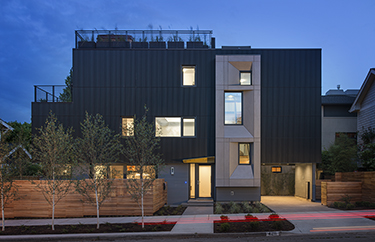|
Subscribe / Renew |
|
|
Contact Us |
|
| ► Subscribe to our Free Weekly Newsletter | |
| home | Welcome, sign in or click here to subscribe. | login |
Environment
| |
 |
September 26, 2013
Lower your energy bill by 75% with a Passive House
NK Architects

Giampietro
|
Today, if we choose, we can construct every building to be in balance with the environment, durable for the long term, and more comfortable than other buildings built merely to code. We can do this by using the best available building science, accurate energy performance analysis and readily available materials and components.
When we build this way the community and the environment benefit, and our investment is recouped over time.
An example of this smarter approach is Park Passive, the first Seattle building certified to meet the stringent energy performance criteria of the Passive House standard.
Park Passive, in the Madison Park neighborhood, is a single-family certified Passive House designed by NK Architects and built by owner/builder Sloan Ritchie of Cascade Built. A certified Passive House is designed to use 75 percent less energy than the typical new home. The benefits of meeting this strict energy requirement include dramatically increasing the comfort of its occupants and bringing long-term value to its owners and the community.
Park Passive employs careful design, high-performance walls and windows, and filtered, pre-heated fresh air. The walls are airtight and resistant to moisture damage while its windows allow for a net solar gain. Fresh air is provided by opening a window, or by a heat recovery ventilation (HRV) system. These methods of solving persistent building problems provide comfort, fresh air and durability. Well-understood building science techniques are now being applied to mainstream buildings and the results are remarkable.
In the Pacific Northwest, our marine climate requires a careful approach to moisture management. Due in part to failed past attempts to increase energy efficiency, today’s high-performance walls have evolved and now solve the moisture, condensation and health problems of our current building stock. The new “air-tight but vapor-open” wall keeps moist air out, reducing by a hundredfold the amount of water that gets into the structure. Vapor transmission allows the wall to “breathe” like skin and provides a lifetime of protection from the elements.
Simply put, a high-performance building is one your children and grandchildren will be able to enjoy and appreciate.
A common question is: What about the air quality, how do you breathe in an airtight building? Air is not leaking in through the walls but is provided by a dedicated fresh air delivery system, the energy-efficient HRV. The resulting fresh, filtered air relieves breathing problems and is healthier for the occupant, the building and for the larger community.
The techniques and materials required to achieve these results are well-understood by building science professionals. As builders begin to put them into practice, they learn that dramatic new technologies are not required.
Higher up-front costs need not be an obstacle. For example, high-performance office building costs are likely to increase only 2 to 4 percent, if at all. On a single-family home, the lower energy bills will easily pay for additional costs over the life of a 30-year mortgage.
Our present course of building to energy codes involves only minor improvements in performance on a year-over-year basis. Since the building envelope, walls and windows will be in place for many years, this approach creates “built in” higher operating costs.
Every building that falls short of the high-performance goal of being in balance with the environment will require expensive renovation later. Alternately, a business decision today to design to high-performance, above-code standards, brings a return of financial value, user health and comfort, and long-term community and environmental benefits. Buildings like Park Passive are the future.
Joe Giampietro, AIA, CPHC, is a managing associate at NK Architects and a Certified Passive House Consultant. He has 30 years of experience in real estate development, land-use planning and architecture.
Other Stories:
- Wastewater plant cleaned up for the 21st century
- What’s next in green building? Seattle has it
- Surveys 2013: Plauche & Carr LLP
- Surveys 2013: Optimum Energy
- Surveys 2013: GeoEngineers
- Surveys 2013: Cascadia Consulting Group
- Surveys 2013: Hart Crowser
- Surveys 2013: Innovex Environmental Management
- Surveys 2013: Shannon & Wilson
- Dairies struggle to balance business and the environment
- Murky floodplain rules sink development plans
- Is your data center as green as it can be?
- Protecting Puget Sound’s marine shorelines
- At the UW, smart grids put a lid on energy use
- Rising sea level threatens Port Gamble tribe
- Surveys 2013: Ridolfi Inc.



